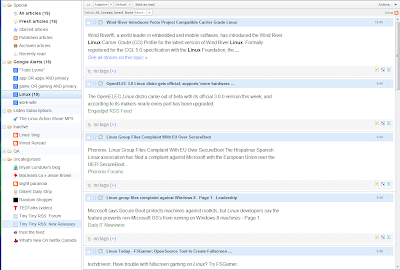Since Google broke the news that it was discontinuing its RSS reader due to declining usage and "privacy concerns", I've been searching for a replacement. I looked at the web-hosted alternatives and while they each had particular appeal, none seemed worth the effort.
Google Reader may not have been the fanciest or most feature-rich platform, but it was Google's and (like the rest of the free world) I already had an account with them. Did I really want to open yet-another account with yet-another company, or worse still, use my Google login credentials to access a competitor's service (as
The Old Reader currently requires)? Not really. That, and the lineups to get into the alternate reader services have been
huge, with so many users mass migrating in advance of Google's July 1 shutdown.
And so I began
ducking around for self-hosted Reader alternatives... and that's when I began to discover many favourable reviews for
Tiny Tiny RSS. Like Google Reader it is a simple, powerful tool for managing feed subscriptions, plus it's free, open source, and mature (in development since 2005).
I had just been contemplating downloading TT-RSS for a test drive when one of my Twitter
contacts linked to a how-to article on LifeHacker,
How to Build Your Own Syncing RSS Reader with Tiny Tiny RSS and Kick Google Reader to the Curb. It was all the push I needed, and in a mere 37 minutes the installation was completed. The only stumbling blocks I experienced were:
- Getting my hostname correct in the configuration file. In the end I looked at the hostname used in the config files of some of my other hosted software to verify the (justifiably) long, complex, impossible-to-guess name.
- The import of my subscription XML file from Google generated an error, then seemed to take forever to import. In the end, it never did seem to finish so I opened a second tab to TT-RSS and saw that, in fact, the import was successful but the notification box had never updated or closed to make that clear.
Other than that, the instructions at LifeHacker were spot on and the process was relatively painless. Here are a couple of snapshots of the result:
 |
| The logo is easily replaced by uploading a new copy of images/logo_wide.png |
 |
| Tah dah! The reader in action |
It's my first full day of use and I'm still figuring out the features, but it's pretty intuitive. If you've got a hosting plan with a database to spare and aren't afraid to give the webtools for MySQL and phpMyAdmin a try, you should give this a shot.
And once you're up and running, try some customization:



















